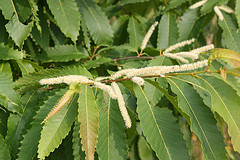
DUBOIS – Aaron Stottlemyer, instructor of forestry at Penn State DuBois, has joined a group of experts who are leading the charge to restore the American chestnut to eastern U.S. forests (a fungus known as chestnut blight wiped out chestnut populations in the early 1900s). He was invited to join The American Chestnut Foundation’s (TACF) Restoration and Ecology Track and recently met with the group at Ohio University in Athens, Ohio. They discussed plans for reintroducing the tree to forests, since seeds of blight-resistant hybrid chestnut trees will be available soon.
“This species accounted for one quarter of our hardwoods before its demise. An estimated four billion trees were killed when chestnut blight, a fungus, was accidentally introduced to the United States from Asia in the early part of the 20th century,” Stottlemyer said. He went on to explain the effect that the loss of the chestnut had on forest ecosystems. “We lost the single largest producer of hard mast for wildlife and the death of these trees dramatically changed plant composition as other trees increased in abundance when they filled in the gaps.”
Reintroducing chestnut to forests will be a complex task. “Forests are very different now than they were before the chestnut blight arrived and we are a long way from fully understanding the ecology of the species. Interestingly, much of this information first started being studied and documented for other tree species as chestnut was on its way out. So, we’re lacking some basic information about things like site requirements that we would otherwise use to help us manage for chestnut,” said Stottlemyer.
TACF has been working on developing a blight-resistant American chestnut. By breeding American chestnuts with the already blight-resistant Chinese chestnut through a process called back-crossing, scientists have developed a hybrid that will be resistant to chestnut blight. “For the past 28 years, TACF’s efforts have largely been focused on producing a blight-resistant hybrid,” said Stottlemyer. “Now, blight-resistant trees are producing seed and it’s time to start thinking about how we reintroduce this species to its native range.”
“Right now, there’s a significant challenge in selecting appropriate sites for the first plantings,” Stottlemyer said. He explained, “We’ll need to identify areas of land where seedlings will have the necessary light, moisture and nutrient levels, and a reasonable chance at competing with other species.”
While there is no exact timeline on when the first plantings will be established, Stottlemyer believes it will happen in the near future.
Stottlemyer said he and his colleagues hope nature will take over once the trees mature and begin to produce seeds, in as soon as six years after they’re planted. “Our hope is that wildlife such as bluejays and squirrels will collect and disperse the seeds,” he said.
Stottlemyer and other Penn State DuBois Wildlife Technology faculty and students work on an ongoing chestnut research project in Jefferson County. There, a farm containing about 2,000 hybrid chestnut saplings is one of approximately 75 chestnut research orchards in Pennsylvania.
Steve Harmic, Penn State DuBois